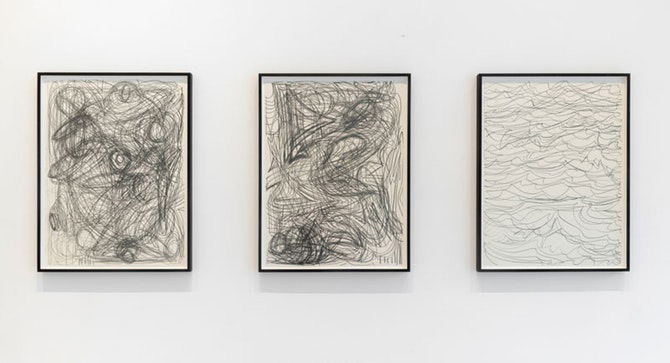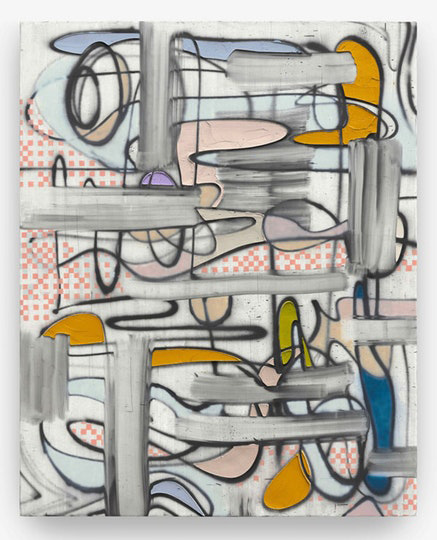
- Source: The Brooklyn Rail
- Author: David Rhodes
- Date: May 01, 2018
- Format: DIGITAL
KELTIE FERRIS:
(F(U(T()U)R)E)
This exhibition of paintings and drawings marks a bold and confident change in the working methods of Keltie Ferris. A significant departure has been made from the characteristically fuzzy and pixelated images taken and transformed from screens present in previous paintings. In their stead is an assertive—and risky—incursion of influence from high profile painters—George Condo, Christopher Wool, and Jonathan Lasker—but especially Wool, of whom Ferris has said, “I feel like Christopher Wool is so influential, he’s almost like our de Kooning right now. Everyone is copying him, or riffing on what he has brought to the table.” Ferris has been an exemplary exponent of a mode of abstraction widespread in New York from the 2000s, an informal formalism that eschews a settled pictorial structure. It’s a pictorial approach long explored by Albert Oehlen, amongst others in Germany and outside the Anglophone world, albeit with a less colorful, hospitable edge. Oehlen and Wool are artists with a close personal and exhibiting history, Wool coming into contact with Oehlen and other Cologne artists as early as the 1980s on visits to that Rhineland city. Ferris, particularly in this exhibition, can be regarded as thoroughly located in this German-American dialogue.

Keltie Ferris, installation view of (F(U(T( )U)R)E) at Mitchell-Innes & Nash, NY, 2018.
The cartoonesque appropriation of both high style and popular culture that ensured playful invention in Ferris’s previous works is now at odds with the spray paint spontaneity and challenging swiped “erasures” imported from Wool. Also at odds pictorially are the fade of soft color and consequent atmospheric and vacillating spatial effects of spray painted areas with inches thick, irregularly shaped sections of marble dust and oil paint made with the use of custom stencils. Conceptually, the contrast of surface painting with impasto brings to mind Lasker’s process of improvisation, present in drawings only, ahead of any painting. The conflation of such extremely contrasting techniques in Ferris’s new paintings has an extraordinary effect. From a distance the paintings read as complex and dynamic painterly spatial structures. But, closer-up, they read as the physical composites that they are, thus separating the roles of visual perception as illusion (representation) from the inescapably physical experience of them as a “body of work” so to speak.

Keltie Ferris, I O, 2018. Oil and acrylic on canvas, 96 by 77 1/8 inches.
Take for example I O (2018), a 96 × 77 inch painting. Not exactly monumental in scale, but large enough to encounter sculpturally and pictorially, its swirling interlocutions motion us to keep looking, following the flow across the painting, one way and then another like the modeled interior surface of a Baroque church. Evident in several parts of the painting are the grey swiped gestures, which function less to blur what she previously put on the canvas, as in a Wool painting, then imply a grid.
The three drawings seen at the entrance to the exhibition display a similar nervous energy found in the paintings but here without any collage-like piecing together of elements. Now the energy is in a linear and scrawled writing without letters. Ferris has spoken of reading and being impressed by Frank Stella’s Working Space based on his Norton Lectures of 1983 – 84. Certainly, Ferris seems to have taken to heart Stella’s call to embrace both the physical extension of painting as well as its capacity to create visual space, and in this most recent presentation the results are powerful to behold.

